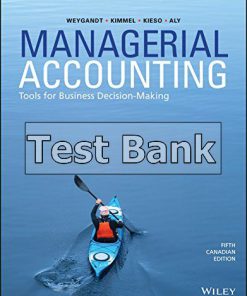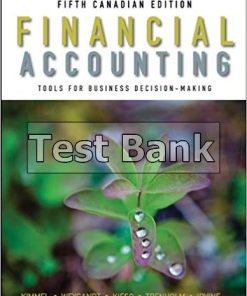Engineering Economics Financial Decision Making for Engineers Canadian 5th Edition Fraser Test Bank
$26.50$50.00 (-47%)
Engineering Economics Financial Decision Making for Engineers Canadian 5th Edition Fraser Test Bank.
You may also like
Engineering Economics Financial Decision Making for Engineers Canadian 5th Edition Fraser Test Bank

Product details:
- ISBN-10 : 0132379252
- ISBN-13 : 978-0132379250
- Author: Fraser, Niall M., Jewkes, Elizabeth M.
Engineering Financial Decision Making for Engineers¿ is designed for teaching a course on engineering economics to match engineering practice today. It recognizes the role of the engineer as a decision maker who has to make and defend sensible decisions. Such decisions must not only take into account a correct assessment of costs and benefits, they must also reflect an understanding of the environment in which the decisions are made. The 5 th edition has new material on project management in order to adhere to the CEAB guidelines as well the new edition will have a new spreadsheet feature throughout the text.
Table contents:
- Chapter 1: Engineering Decision Making
- Introduction: Engineering Decision Making
- 1.1 Engineering Decision Making
- 1.2 What Is Engineering Economics?
- 1.3 Making Decisions
- 1.4 Dealing with Abstractions
- 1.5 The Moral Question: Three True Stories
- Analysis of the Examples
- Case in Point 1.1: Loss of Life in Engineering Projects
- 1.6 Uncertainty and Sensitivity Analysis
- 1.7 How This Book Is Organized
- Study Exercises
- B. Applications
- C. More Challenging Problem
- Mini-Case 1.1: R. v. Syncrude Canada Ltd.
- Chapter 2: Time Value of Money
- Introduction: Time Value of Money
- 2.1 Interest and Interest Rates
- 2.2 Compound and Simple Interest
- Compound Interest
- Simple Interest
- 2.3 Effective and Nominal Interest Rates
- 2.4 Continuous Compounding
- 2.5 Cash Flow Diagrams
- 2.6 Depreciation
- Reasons for Depreciation
- Value of an Asset
- Straight-Line Depreciation
- Declining-Balance Depreciation
- Case in Point 2.1: Guilty Figures
- 2.7 Equivalence
- Summary
- Review Problems
- Review Problem 2.2
- Review Problem 2.3
- Review Problem 2.4
- Study Exercises
- B. Applications
- C. More Challenging Problems
- Mini-Case 2.1: Student Credit Cards
- Chapter 3: Cash Flow Analysis
- Introduction: Cash Flow Analysis
- 3.1 Timing of Cash Flows and Modelling
- 3.2 Compound Interest Factors for Discrete Compounding
- 3.3 Compound Interest Factors for Single Disbursements or Receipts
- 3.4 Compound Interest Factors for Annuities
- 3.5 Conversion Factor for Arithmetic Gradient Series
- Case in Point 3.1: The RIM Park Scandal
- 3.6 Conversion Factor for Geometric Gradient Series
- 3.7 Non-Standard Annuities and Gradients
- 3.8 Present Worth Computations When N→∞
- Summary
- Review Problems
- Review Problem 3.2
- Review Problem 3.3
- Review Problem 3.4
- Study Exercises
- B. Applications
- C. More Challenging Problems
- Mini-Case 3.1: The Canadian Oil Sands
- Appendix 3A Derivation of Discrete Compound Interest Factors
- Chapter 4: Comparison Methods Part 1
- Introduction: Comparison Methods Part 1
- 4.1 Relations Among Projects
- 4.2 Minimum Acceptable Rate of Return (MARR)
- Case in Point 4.1: Dirk’s New Venture
- 4.3 Present Worth (PW) and Annual Worth (AW) Comparisons
- Present Worth Comparisons for Independent Projects
- Present Worth Comparisons for Mutually Exclusive Projects
- Annual Worth Comparisons
- 4.4 Comparison of Alternatives with Unequal Lives
- 4.5 Payback Period
- Advantages and Disadvantages of the Payback Period Method
- Summary
- Review Problems
- Review Problem 4.2
- Review Problem 4.3
- Study Exercises
- B. Applications
- C. More Challenging Problems
- Mini-Case 4.1: Rockwell International
- Appendix 4A The MARR and the Cost of Capital
- Risk and the Cost of Capital
- Company Size and Sources of Capital
- Chapter 5: Comparison Methods Part 2
- Introduction: Comparison Methods Part 2
- 5.1 The Internal Rate of Return
- 5.2 Internal Rate of Return Comparisons for Independent Projects
- 5.3 Internal Rate of Return Comparisons for Mutually Exclusive Projects
- Systematic Analysis of Mutually Exclusive Alternatives with the IRR Method
- Case in Point 5.1: The Economics of Electric Vehicles
- 5.4 Multiple IRRs
- 5.5 External Rate of Return Methods
- When to Use the ERR
- 5.6 Equivalence of Rate of Return and Present/Annual Worth Methods
- 5.7 Levelized Cost
- 5.8 Why Choose One Method over the Other?
- Summary
- Review Problems
- Review Problem 5.2
- Review Problem 5.3
- Study Exercises
- B. Applications
- C. More Challenging Problems
- Mini-Case 5.1: The Galore Creek Project
- Chapter 6: Financial Accounting and Business Plans
- Introduction: Financial Accounting and Business Plans
- 6.1 Elements of Financial Accounting
- Measuring the Performance of a Firm
- The Balance Sheet
- The Income Statement
- Estimated Values in Financial Statements
- Financial Ratio Analysis
- Financial Ratios
- 6.2 Preparing a Business Plan
- Case in Point 6.1: Dirk’s Business Plan
- Executive Summary
- Company Description
- Case in Point 6.2: Dirk’s Business Plan: Company Description
- Market Analysis/Future Outlook
- Case in Point 6.3: Dirk’s Business Plan: Market Analysis
- Management and Organization
- Funding Requirements
- Case in Point 6.4: Dirk’s Business Plan: Management and Funding Requirements
- Sales and Marketing
- Case in Point 6.5: Dirk’s Business Plan: Sales and Marketing
- Appendix
- Summary
- Review Problems
- Review Problem 6.2
- Review Problem 6.3
- Study Exercises
- B. Applications
- C. More Challenging Problems
- Mini-Case 6.1: BlackBerry
- Appendix 6A Cost Estimation
- Cost Concepts
- Cost Estimation Methods and Classification of Cost Estimates
- Adjusting for Inflation, Location, and Other Factors
- Cost Estimating Relationships
- Dealing with Indirect Costs
- Problems
- Chapter 7: Replacement Decisions
- Introduction: Replacement Decisions
- 7.1 A Replacement Example
- 7.2 Reasons for Replacement or Retirement
- 7.3 Capital Costs and Other Costs
- 7.4 Defender and Challenger Are Identical
- 7.5 Challenger Is Different from Defender; Challenger Repeats Indefinitely
- Case in Point 7.1: Nuclear Power in Ontario
- 7.6 The Irrelevance of Sunk Costs
- 7.7 When Capital or Operating Costs Are Non-monotonic
- 7.8 Challenger Is Different from Defender; Challenger Does Not Repeat
- Summary
- Review Problems
- Review Problem 7.2
- Review Problem 7.3
- Study Exercises
- B. Applications
- C. More Challenging Problems
- Mini-Case 7.1: How Green Is Your Data?
- Chapter 8: Taxes
- Introduction: Taxes
- 8.1 Personal Income Taxes and Corporate Income Taxes Compared
- 8.2 Corporate Tax Rates
- 8.3 Before- and After-Tax MARR
- 8.4 The Effect of Taxation on Cash Flows
- The Effect of Taxes on First Cost
- The Effect of Taxes on Savings
- The Effect of Taxes on Salvage or Scrap Value
- 8.5 Present Worth and Annual Worth Tax Calculations
- 8.6 IRR Tax Calculations
- Approximate After-Tax Rate of Return Calculations
- 8.7 The Capital Cost Allowance System
- 8.8 Undepreciated Capital Cost and the Half-Year Rule
- 8.9 The Capital Tax Factor and Capital Salvage Factor
- 8.10 Components of a Complete Tax Calculation
- Summary
- Review Problems
- Review Problem 8.2
- Review Problem 8.3
- Review Problem 8.4
- Study Exercises
- B. Applications
- C. More Challenging Problems
- Mini-Case 8.1: Tax Flight—Myth or Reality?
- Appendix 8A Deriving the Capital Tax Factor
- Chapter 9: Inflation
- Introduction: Inflation
- 9.1 Measuring the Inflation Rate
- 9.2 Economic Evaluation with Inflation
- Converting Between Real and Current Dollars
- 9.3 The Effect of Correctly Anticipated Inflation
- The Effect of Inflation on the MARR
- The Effect of Inflation on the IRR
- 9.4 Project Evaluation Methods with Inflation
- Summary
- Review Problems
- Review Problem 9.2
- Review Problem 9.3
- Review Problem 9.4
- Study Exercises
- B. Applications
- C. More Challenging Problems
- Mini-Case 9.1: Economic Comparison of High-Pressure and Conventional Pipelines: Associated Engineering
- Appendix 9A Computing a Price Index
- Chapter 10: Public Sector Decision Making
- Introduction: Public Sector Decision Making
- Case in Point 10.1: Private Ownership, Public Goods
- 10.1 Market Failure
- Market Failure Defined
- Remedies for Market Failure
- 10.2 Decision Making in the Public Sector
- The Point of View Used for Project Evaluation
- 10.3 Identifying and Measuring the Costs and Benefits of Public Projects
- Identifying and Measuring the Costs of Public Projects
- Identifying and Measuring the Benefits of Public Projects
- 10.4 Benefit–Cost Ratios
- 10.5 The MARR in the Public Sector
- Summary
- Review Problems
- Study Exercises
- B. Applications
- C. More Challenging Problems
- Mini-Case 10.1: Carbon Neutrality vs. Food Security in the North
- Chapter 11: Project Management
- Introduction: Project Management
- 11.1 Project Management Life Cycle
- Initiation
- Planning
- Execution
- Monitoring and Controlling
- Closure
- 11.2 Work Breakdown Structure
- 11.3 Gantt Charts
- 11.4 Network Representation of the Schedule: CPM and PERT
- Case in Point 11.1: Waterloo Light Rail Transit
- Project Scheduling and the Critical Path Method
- Project Crashing and Time–Cost Tradeoffs
- Summary
- Review Problems
- Review Problem 11.1
- Review Problem 11.2
- Review Problem 11.3
- Review Problem 11.4
- Study Exercises
- B. Applications
- C. More Challenging Problems
- Mini-Case 11.1: No Longer LEEDing
- Chapter 12: Dealing with Uncertainty and Risk
- Introduction: Dealing with Uncertainty and Risk
- 12.1 Sensitivity Graphs
- Case in Point 12.1: Oil Spills
- 12.2 Break-Even Analysis
- Break-Even Analysis for a Single Project
- Break-Even Analysis for Multiple Projects
- 12.3 Structuring Decisions with Decision Trees
- Summary
- Review Problems
- Review Problem 12.1
- Review Problem 12.2
- Review Problem 12.3
- Review Problem 12.4
- Study Exercises
- B. Applications
- C. More Challenging Problems
- Mini-Case 12.1: China Steel Australia Limited
- Chapter 13: Qualitative Considerations and Multiple Criteria
- Introduction: Qualitative Considerations and Multiple Criteria
- 13.1 Qualitative Considerations
- 13.2 Efficiency
- 13.3 Decision Matrixes
- 13.4 The Analytic Hierarchy Process
- 13.5 The Consistency Ratio for AHP
- Summary
- Review Problems
- Study Exercises
- B. Applications
- C. More Challenging Problem
- Mini-Case 13.1: Northwind Stoneware
- Appendix 13A Calculating the Consistency Ratio for AHP
- Problems for Appendix 13 A
- Appendix A Compound Interest Factors for Discrete Compounding, Discrete Cash Flows
- Appendix B Answers to Selected Problems
- Appendix C List of Symbols
- Appendix D List of Formulas
- Glossary
- Credits
People also search:
engineering economics financial decision making for engineers canadian 5th
engineering economics financial decision making for engineers canadian 5th edition
engineering economics financial decision making for engineers canadian 5th pdf
engineering economics financial decision making for engineers canadian 5th pdf free
engineering economics financial decision making for engineers canadian 5th download scribd












